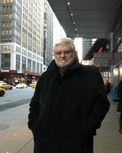 Chris
McDonnell, UK
Chris
McDonnell, UKchris@mcdonnell83.freeserve.co.uk
 Chris
McDonnell, UK
Chris
McDonnell, UK
chris@mcdonnell83.freeserve.co.uk
Previous articles by Chris
Comments
welcome here
February
2, 2017:
The
mystery in the image
Around
our homes are photographs of our families, our own children, their
weddings and the grandchildren it has been our blessing to have. Their
images remind us of many shared occasions when we have been together,
enjoyed each other’s company and celebrated family events.
In
placing pictures on tables or hanging them on walls they are there to
remind us of a greater reality that goes beyond the framed photograph.
Beautiful though they are, they are, in reality, nothing more than memory.
A
bare house, without ornaments or photographs would offer cold comfort for
the place we call home. We like to have around us things we associate with
good memories, places we have visited, gifts we have been given. We make
our nest and we feel at home.
In
the same way the design and decoration of our churches offer that same
homeliness, familiarity and warmth. But there is a difference. The items
we find in church are not there purely for decorative effect, but have
primarily a liturgical significance.
Look
around your own church. There will be a large crucifix over or behind the
main altar, the tabernacle for Reservation lit by the sanctuary lamp,
statues relevant to the Church and along the walls, the Stations of the
Cross. It is the familiar interior of a Catholic church that is our
heritage.
Over
recent years the icon image, so central to the Orthodox practice, has
gained acceptance in the
In
the early Church, images became items of veneration associating
communities with saints and martyrs. Confusion arose when the accusation
was made that such images were being ‘adored’, in other words seen as
a replacement for the one God to whom adoration was owed.
This
led to the actions of those whom we call iconoclasts, who destroyed or
defaced such icons with brutal efficiency. They were restored to use in
843, a date celebrated in the East as the Triumph of Orthodoxy.
Such
destructive activity has occurred often, taking the form of a vindictive
movement in times of extreme change. The years of Reformation in
It
happened again during the Revolution in
In
our own time we have seen attacks on churches and mosques as part of a
terrorist movement and once again objects of beauty and value have been
desecrated and destroyed.
END
---------------